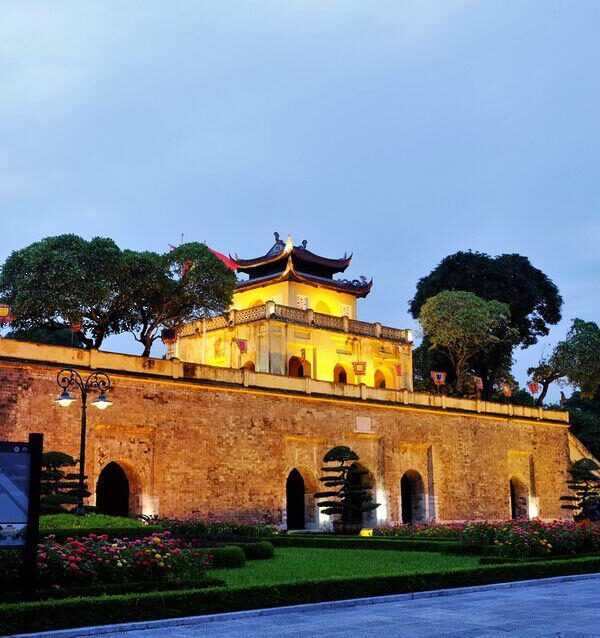Imperial Citadel of Thang Long is a historical relic of the ancient citadel of Thang Long, starting from the pre-Thang Long period (7th century) through the Dinh – Tien Le period, and was strongly developed under the Ly, Tran, Le, and Hanoi under the Nguyen Dynasty.
This is a monumental architectural work, built by dynasties in many historical periods and becomes the most important relic in the system of monuments of Vietnam. Imperial Citadel of Thang Long has been recognized by UNESCO as the world’s cultural heritage.

Introduction
The Imperial Citadel of Thang Long now belongs to Dien Bien and Quan Thanh wards, Ba Dinh district, Hanoi. The Imperial Citadel of Thang Long has a total area of 18,395ha, including archaeological sites of 18 Hoang Dieu and other relics left in the historic Hanoi Citadel such as Doan Mon, Hanoi flagpole, Kinh Thien Palace, D67 house, Bac Mon, Hau Lau, the citadel walls and 8 palace gates under the Nguyen dynasty.
These monuments are located in Ba Dinh district and are limited by routes: the North is Phan Dinh Phung Street, the South is Bac Son Street and the National Assembly Building, the Southwest is Dien Bien Phu Street, the West is Hoang Dieu Street, Doc Lap Street, National Assembly House and finally on the East side is Nguyen Tri Phuong street. This is a sure tourist destination you will not be able to miss when traveling to Hanoi.
How to get to the Imperial Citadel of Thang Long?
To visit Thang Long Citadel, you go to 19C Hoang Dieu, this is the main gate for visitors. From the center of Hanoi, you can easily go to the Imperial Citadel by means of vehicles such as motorbikes, bicycles, cars, buses … If you take the bus you can take route 22, this bus will stop at the gate of the Imperial City.
Places to visit in the Imperial Citadel of Thang Long
Archaeological Area 18 Hoang Dieu

This relic includes the bottom floor which is an eastern part of Dai La citadel under the Cao Bien Dynasty, the Tang Dynasty, the upper floor of the Ly and Tran palaces, followed by a central part of the eastern palace of the Le and the top is a part of the 19th-century Hanoi city center.
The Flag Tower of Hanoi

Hanoi flagpole is a relic built-in 1812 during the Gia Long dynasty. The flagpole is 60m high, including the base, the column body, and the gazebo. The base is square in shape with an area of 2007m² and consists of 3 tapering levels. Each level is surrounded by floral walls and patterns.
From the ground up to the foot of the 2nd level, you must climb 18 steps on the East and West faces. Want to go from level 2 to level 3 must also climb 18 steps at the two doors east and west. The third level has 4 doors, the East, the West, the South, and the North.
Kinh Thien Palace
This is the central relic, the main nucleus in the overall historical vestiges of Hanoi ancient citadel. Kinh Thien Palace is located in the center of the relic. In front of Kinh Thien Palace is Doan Mon temple, then Hanoi flagpole, behind there are Hau Lau, Cua Bac, two east and west with walls and small doors.

Currently, traces of Kinh Thien Palace remain only in the old foundation area. The south side of the powerhouse has rows of railings more than one meter high.
The front, south-facing direction of Kinh Thien Palace built a stepping system with large stone slabs. The terrace consists of 10 steps, 4 stone dragons divided into 3 equal paths to form a dragon platform.
Hau Lau
Also known as Lau Tinh Bac (Tinh Bac Lau) is a building behind Kinh Thien architectural cluster is the palace of Hanoi ancient citadel. Although it is behind the palace but it is the north, built with the intention of feng-shui to keep the north of the palace. This is also the residence of the queen and princesses during the feudal period.
Cua Bac – North Gate

This is one of the five gates of Hanoi under the Nguyen Dynasty. In Cua Bac, two cannons are still retained by French cannons fired from the Red River in 1882 when the French lowered Hanoi citadel for the second time.
Today, on the gate is the place to worship the two Hanoi governors Nguyen Tri Phuong and Hoang Dieu.
House D67

This is where the Ministry of Defense, the Politburo, and the Central Military Commission have made historic decisions marking the milestones of the Vietnamese revolution.
Those were the Tet offensive in 1968 and 1972 and the culmination was the Ho Chi Minh campaign in 1975 to liberate the South and reunify the country.
FAQs – The Imperial Citadel of Thang Long
From Tue – Sun.
Open time:
– Morning: 8:00 – 11:30;
– Afternoon: 14h00 – 17h00
Adults: 30,000 VND/ticket
Free admission for children under 15 years old.
Unnecessary. There will be a ticket office at 19C Hoang Dieu, Dien Ban, Ba Dinh, Hanoi and you will buy tickets directly there.
These are the best ways to experience the Imperial Citadel of Thang Long:
– Bon Bon Hanoi City Tour – Discover Hanoi by bus, a new experience for visitors.
– Hanoi free walking tour
– Cyclo tour


One thought on “Imperial Citadel of Thang Long – A guide to visiting this UNESCO citadel”